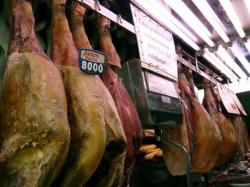Cured Meat: Jamon Serrano, Fuet, Salame & Other Charcuterie
April 13, 2010 | 2 min to read

Like any good American kid, I grew up eating floppy baloney on white bread. And like any uninspired Manhattan office worker, I ambled down to the nearest deli and got slices of salami — hot pink and encased in branded, shrink-wrap plastic that the sandwich guy would peel back to measure out my portion. It was salty and tasted fine between sliced bread with a handful of shredded iceberg lettuce, or at least it seemed that way from inside my cubicle. Then I moved to Europe.
Across the plaza from my apartment in Madrid was a butcher. In the window were long, powdery sausages and waxy pork hindquarters hung with the black hoof pointing up at the ceiling, a stilettoed come-hither for the hungry. I heeded its call.
An obvious foreigner in a neighborhood of octogenarians, José, the garrulous, old charcutero, took it upon himself to introduce me to his repertoire of cured meats, cutting off paper thin slices and passing them over the counter along with a squirt from the wineskin. In this way I grew to love fuet, a humble sausage, thin and chewy, coated in floury dust. I was taught to appreciate jamón, the whole preserved leg on the bone. I started with ‘economical’ variety, then moved on to a fine jamón serrano, and finally jamón Ibérico de bellota, from the Black Iberian Pig. Fed on acorns, its meat was a deep purple, rich, earthy, and marbled with fat. I ate morcilla, blood sausage mixed with rice or sweet potatoes, until I was ill. I kept lomo, the mild, cured whole pork loin, always stocked in my refrigerator. And I still dream about chorizo, dry and deep red, with spots of fat stained with paprika.
Drying Fuet Sausages
Back in America, fear of the prospect of eating salami that tasted more of salt than meat was enough to make me resign myself to never eating sausage outside of Europe again. Luckily, I’d moved to California where the food-obsessed gather, and it did not take long to stumble into Boccalone’s salumería in San Francisco’s Ferry Building. In the tiny storefront hung meats that rivaled the taste and complexity of my beloved charcutería in Madrid. Boccalone represents a growing movement towards artisanal cured meats in America. Cured in their factory across the bay in East Oakland, Boccalone produces meats in the Italian tradition. Close enough for me.
To read the rest of this story, please go to: Kaufmann Mercantile
